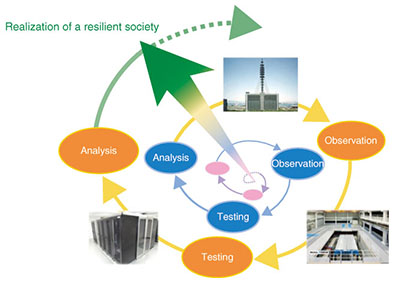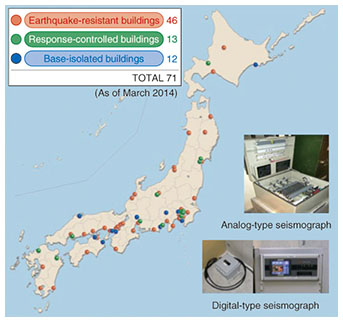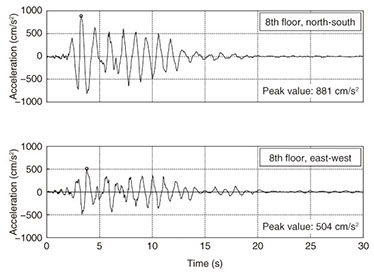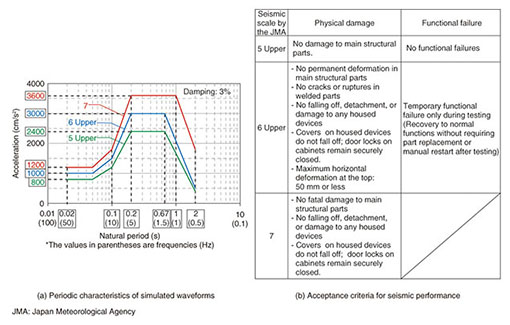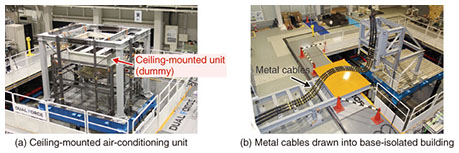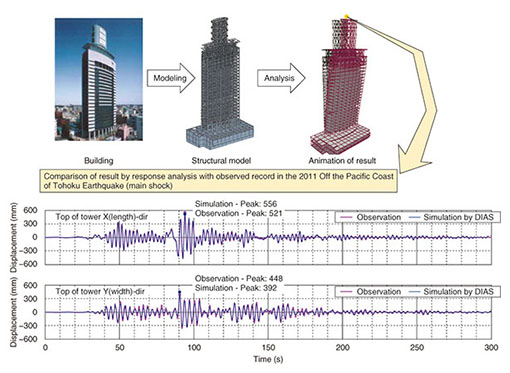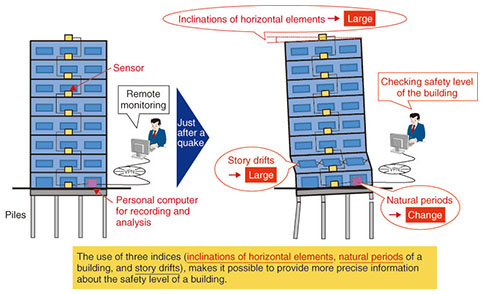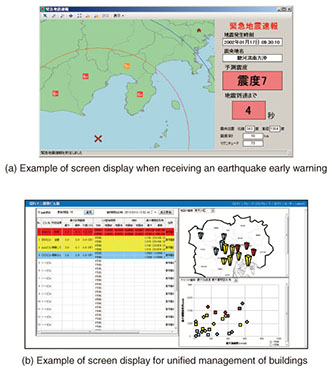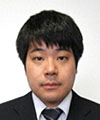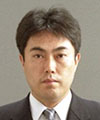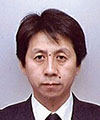 |
|||||||||||||||
|
|
|||||||||||||||
|
Feature Articles: R&D Efforts at NTT FACILITIES Vol. 12, No. 11, pp. 81–88, Nov. 2014. https://doi.org/10.53829/ntr201411fa13 Engineering for Earthquake Disaster Prevention Based on Observations, Experiments, and AnalysesAbstractNTT FACILITIES has established three unique earthquake resistant techniques used for observations, experiments, and analyses in order to provide a reliable telecommunications infrastructure. We aim to realize a resilient society and are therefore working on developing new technology for earthquake disaster prevention by further advancing and linking these existing techniques. We introduce in this article an overview of these techniques and also describe the concept of structural health monitoring that has been a recent focus of development. Keywords: earthquake disaster prevention, resilience, structural health monitoring 1. IntroductionNTT FACILITIES has been developing unique earthquake resistant techniques for buildings and equipment that constitute the telecommunications infrastructure. These techniques have been continuously developed since the days of the Nippon Telegraph and Telephone Public Corporation. Because Japan is a country with considerable seismic activity, NTT FACILITIES has established three methods of seismic observation, vibration testing, and structural analysis. These techniques have also been improved over time in order to provide and operate a strong and reliable telecommunications infrastructure. We are working on not only improving the technology for the telecommunications infrastructure, but also developing society-wide earthquake disaster prevention technology by further advancing and linking the three techniques. Major earthquakes are still a primary concern to society as a whole, so one of the missions of NTT FACILITIES is to realize a resilient society through development and improvement of earthquake disaster prevention technology (Fig. 1).
2. Observation of seismic shaking in buildingsThe development of earthquake resistant engineering originated from a desire to learn as much as possible from seismic damage that occurred in the past. Damage factors need to be clarified scientifically in order to learn from such damage, and seismic observation serves as a foundation for this. Seismic observation involves the use of a measurement instrument called a strong-motion seismograph. This instrument is fixed on the ground or on the floor surface of a building, and it records the shaking caused by earthquakes. Strong-motion seismographs to observe only ground motion have been deployed by the national and local governments in many places [1]. In contrast, the number of seismographs to observe building shaking by earthquakes is much smaller, although it is gradually increasing. The NTT Group has installed its own seismographs to measure the shaking of buildings and has been conducting seismic observations in NTT buildings nationwide. The history of seismic observation in the NTT Group goes back more than half a century, when two seismographs were installed at the Koto Telephone Office Building (Tokyo) in 1960. Since then, seismic observation systems have been installed in various types of buildings such as high-rise buildings and base-isolated buildings (buildings whose bases are not fixed to the ground). Seismic observation is now being conducted in 71 buildings nationwide (Fig. 2). During the 2011 Off the Pacific Coast of Tohoku Earthquake* (main shock), strong shaking motions of buildings caused by the earthquake were recorded at observation points in Sendai and other areas across the country.
NTT FACILITIES has determined how buildings shake during an earthquake by analyzing the strong-motion records obtained from the observation points over the years and has utilized this information in evaluating the seismic performance of telecommunications equipment installed in the buildings. In particular, in the 1995 Hyogo-ken Nanbu Earthquake, valuable strong-motion records were obtained at the NTT Kobe Ekimae Building (Fig. 3). At that time, there were only a few cases of seismic observation of building motion in Japan; consequently, the successful acquisition of strong-motion records of an entire building in the disaster area in Kobe attracted a lot of attention in academia. The seismic records were reflected in the document “Seismic Testing Method for Telecommunications Equipment,” which is now a standard for evaluating the seismic performance of telecommunications equipment installed in NTT buildings [2], and these records have contributed to improving the reliability of NTT’s telecommunications services. Furthermore, the seismic records have contributed to the development of seismic technology in Japan as data used to understand the dynamic characteristics of buildings during large earthquakes, and have also been utilized as seismic waveforms for structural design such as high-rise buildings and base-isolated buildings.
3. Vibration testing to evaluate seismic performanceVibration testing is an effective means of understanding the dynamic characteristics of telecommunications equipment in a real setting during an earthquake and for confirming the seismic performance of equipment, for example, whether physical damage or functional failures occur in the equipment. Moreover, it is also effective for examining whether developed seismic countermeasures are truly efficient and whether any unexpected situations occur when they are applied. Telecommunications equipment installed in NTT buildings must satisfy a prescribed level of seismic performance. The seismic performance is evaluated using vibration testing with a shaking table in accordance with the standard described previously [2]. In the vibration testing, actual equipment is installed on the shaking table, and the equipment is shaken by reproducing simulated seismic waveforms with periodic characteristics, as shown in Fig. 4(a). This makes it possible to determine whether the equipment has been installed adequately and whether its performance satisfies the criteria as shown in Fig. 4(b). The characteristics of the simulated waveforms shown in Fig. 4(a) are defined on the basis of technical knowledge obtained by analyzing strong-motion records, which reflect the dynamic characteristics of telecommunications buildings of NTT [3, 4].
The first shaking table was introduced in the NTT Group in 1971, and ever since then, the seismic performance of telecommunications equipment has been evaluated in order to ensure the quality of NTT’s telecommunications services. NTT FACILITIES introduced its newest shaking table in 2010, a three-dimensional (3D) vibration testing system called DUAL FORCE [5]. The size of the shaking table is 4 m × 3 m, and it is possible to reproduce a broad range of short- to long-period vibrations. In addition, since the shaking table can move horizontally up to 1.1 m (zero to peak), it can reproduce vibration phenomena with large displacement such as shaking on an upper floor of a high-rise building subjected to long-period ground motion. It is utilized to evaluate the performance of equipment and fixtures installed in various environments and to develop seismic countermeasures. We describe here some recent examples of tests conducted using DUAL FORCE. A photograph of a test on a ceiling-mounted air-conditioning unit is shown in Fig. 5(a). This test was conducted to investigate what caused the unit to fall in the 2011 Great East Japan Earthquake and to verify countermeasures to prevent it from falling. A photograph of a test done to verify the flexibility of metal cables drawn into a base-isolated telecommunications building is shown in Fig. 5(b).
When conducting vibration tests where various environments are simulated, we utilize not only seismic records obtained by observation, but also techniques for simulating the behaviors of various structures obtained by structural analysis. The combination of observation and simulation expands the range of techniques that can be used to evaluate seismic performance by vibration testing. 4. Simulation of seismic behavior of structures by structural analysisIn order to construct a reliable telecommunications infrastructure that can withstand a severe seismic risk, it would be ideal, and perhaps even technically possible, to design building structures that would not be damaged at all during the largest imaginable earthquakes. However, this would require an excessive investment, which is not always desirable in practice. It would be more realistic to set a seismic level to aim for zero damage and to design structures to allow some minimal damage from earthquakes beyond the set level. However, a design that allowed some damage would require a dynamic analysis program that could simulate precisely the process whereby a structural member of a building changes from elastic to plastic under a seismic load. NTT FACILITIES developed DIAS (Dynamic Inelastic Analysis System) in 1991 before spinning-off from NTT. Utilizing DIAS makes it possible to precisely simulate the 3D behaviors of structures in the event of dynamic and non-stationary disturbances such as earthquakes, and the results can be checked using animation (Fig. 6).
Seismographs have been installed in four places in a high-rise building of the NTT Group in Sendai, both inside the building and at the top of its tower. When the main shock of the 2011 Off the Pacific Coast of Tohoku Earthquake occurred, strong motion was recorded at each observation point on the building. A comparison of the observed motion recorded at the top of the tower during the earthquake and the result of the response analysis by DIAS indicated that they were well matched (Fig. 6). This shows that DIAS can simulate very precisely the extent of damage that might occur in buildings [6]. 5. Health monitoring for structuresWhen building structures are damaged in a large earthquake, a technique known as structural health monitoring is used to examine the state of damage and to evaluate the necessity of reinforcing the structures or taking further action. Building structures usually have various materials covering them on both the interior (e.g., sheetrock, wallpaper, ceiling boards) and exterior (e.g., curtain walls, tiles), and the parts that can be inspected directly are limited. Therefore, it is necessary to remove the materials in order to visually confirm the state of the structural elements of an entire building. However, this is rarely done in view of the prohibitive cost and time required for removing the materials and re-applying them after. Structural health monitoring is a technique for identifying which components in a structure have been damaged or degraded by an earthquake, grasping the degree of damage, and evaluating the health of the structure without having to visually check it, by installing sensors such as seismographs in the structures and analyzing the measured data. Structural health monitoring thus involves analyzing and examining a structure using data obtained by sensors and may therefore be described as a technique that was developed from seismic observation. There are two key elements in this technique: the sensor and the damage detection method. It is necessary to accurately identify the damaged elements of a structure and the degree of damage by using an efficient detection method with the minimum necessary number of low-cost sensors. The damage predictions of large earthquakes occurring along the Nankai Trough and under the Tokyo metropolitan area were reviewed after the Great East Japan Earthquake. The most serious results were announced, which consequently increased the demand for a system that can reliably determine whether a building will be able to be used safely immediately after an earthquake. NTT FACILITIES developed a low-cost sensor and a method for evaluating the safety level of a building that can be applied for structural health monitoring and also started selling the Yure-Moni® support system to determine building safety levels on October 1, 2013 (Fig. 7). Conventionally, only story drifts (inclinations of vertical elements) has been used as an index to evaluate the damage state of a building. In contrast, Yure-Moni uses three indices: inclinations of horizontal elements, the natural periods of a building, and story drifts, to evaluate the damage state of a building. Checking the damage state from various aspects in this way makes it possible to provide more accurate and precise information about the safety level of a building just after an earthquake, and even building managers who are not professional engineers can make a proper determination.
Currently, in order to enhance the functions of Yure-Moni as a tool for disaster control before and after an earthquake, we are focusing on adding earthquake early warning functions and unified building management functions to it (Fig. 8). Furthermore, in the future, we are planning to increase the precision of damage detection methods using structural analysis by DIAS and to expand the field of applications of Yure-Moni to civil engineering structures such as road bridges.
6. The present and future of earthquake disaster preventionThe Tohoku region has experienced many large earthquakes, including the 1978 Miyagi-ken-oki Earthquake and the 2008 Iwate-Miyagi Nairiku Earthquake. More than three years have passed since the Great East Japan Earthquake occurred. The number of buildings that collapsed or were structurally damaged in that earthquake was small and limited. However, examples of damage caused by the collapse and fall of nonstructural elements in buildings far from that earthquake’s epicenter were confirmed over a wide area from the Tohoku region to the Kinki region. In the Tokyo metropolitan area in particular, damage resulting in human fatalities occurred because of a collapsing ceiling. NTT FACILITIES is working to prepare for a major earthquake that will undoubtedly occur in the near future by developing countermeasures to problems revealed by the Great East Japan Earthquake. We will continue to develop new technology for earthquake disaster prevention in order to realize resilient societies in other countries where earthquakes occur as frequently as they do in Japan. References
|
|||||||||||||||

